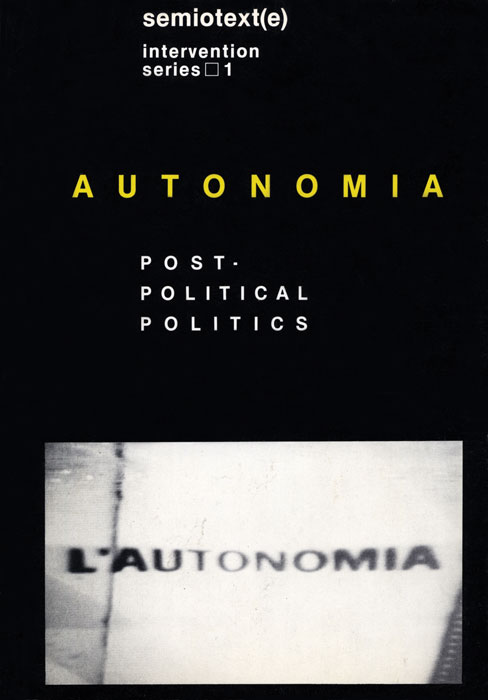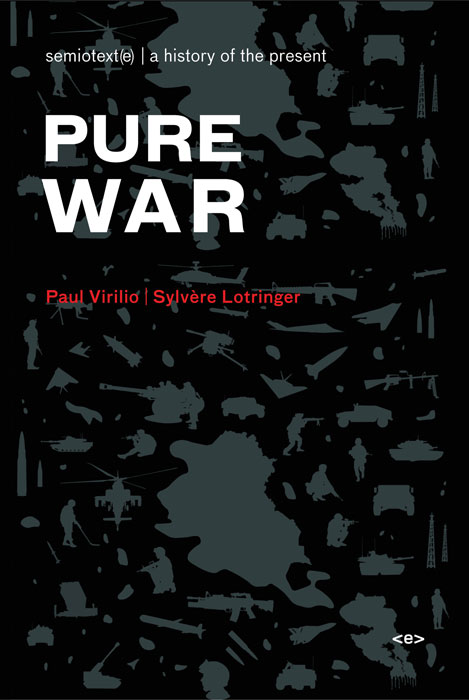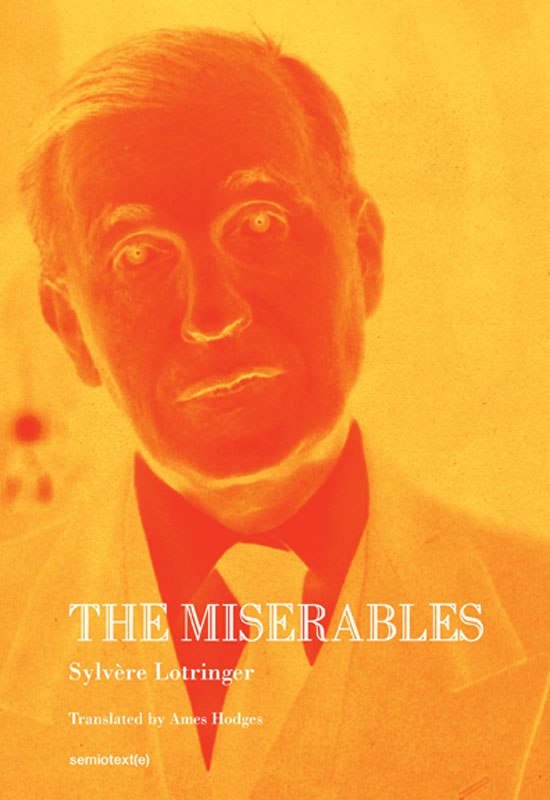« Features
Resisting No Matter What. A Conversation with Sylvère Lotringer
Philosopher Sylvère Lotringer talks with Jason Hoelscher about networks of networks, art worlds, meaning, and whether resistance is still possible.
Sylvère Lotringer is Professor Emeritus at Columbia University, and Professor of Ethico-Aesthetics at the Institute for Doctoral Studies in the Visual Arts. Founder of Semiotext(e) and organizer of the seminal Schizo-Culture Conference that introduced French theory to the United States, Lotringer divides his time between Baja California and New York City.
Jason Hoelscher - Over the last few days I’ve been looking over some of your writings, and a thought stuck out that I’d like to get some more input on. Paraphrasing, you stated that contemporary culture is a capitalist Möbius strip. There is no longer another side to it. To start off, I was wondering if you could elaborate on that idea.
Sylvère Lotringer - We live in a world in which everything is constantly evolving and revolving, everything circulating through networks which instantly communicate with myriads of other networks. So it is very important to understand how the entire system works, and how it represents itself. Outwardly it appears as a decentralized system, a global rhizome moving with near speed of light, a complex semiosphere without inside or outside, which keeps reversing itself seamlessly. This system is all the more imperceptible that it circulates everywhere. It blocks the horizon, and we don’t have enough distance to identify it for what it is. And yet, looking at it from closer up, we may perceive the main structures of this dizzying technological maze. It is powered by banks and international corporations that operate with near autonomy, according to some quasi-automatic strategies. So the image of the rhizome appears overall adequate, but the intricate systems of command are still prevalent and it just takes something unexpected-a financial crash, terrorist attack-to reveal the way they operate and what they really are about.
J.H. - Speed and decentralization seems to have really taken root in the art world as well. It seems in the last decade the art world’s relationship to culture at large has changed. You just mentioned the importance of thought and tools for thought; what do you think are the roles for thought or of art in resistance today?
S.L. - The art world has changed immensely over the last few decades, but so has society in general. Both have followed the very same curve, and we can’t blame art alone for what it has become, only regret that it hasn’t managed to preserve its singularity. That’s the least a world dealing with art could do. At this point the art world is hardly different from any other corporation, except that it is more directly enmeshed with finances. It has created for itself a world of glamour and luxury unequalled anywhere else. Auctions now fetch millions of dollars, often superior to the national budget of many struggling countries, making it a special preserve for the international oligarchy. This makes it all the more surprising that none of the artists who occupied Wall Street had the idea of occupying Christie’s, or other auction houses, where the transmutation of values is being celebrated live.
Resistance begins at home. I don’t call resistance the various forms of critique, which play in the hand of institutions, all the more strident for being dependent on them.
A sizeable portion of young artists are critical of the art institutions, and of the kind of life they offer, but do they really want to change the way their own world is being run? At this point it is being handed down to them ready-made and they struggle to fit in it as best they can. Today’s art world embodies all the excesses of private enterprise and the neo-liberalist economy. Whether or not the global acceleration and fragmentation that we are experiencing can be resisted is a moot question. Technological progress comes to us as a by-product of the military industry, and it seems to be irreversible. Resistance is preempted from the start and invoking it is at best a kind of mantra, a stance-a “resist-stance”-meant to assuage the general sense of powerlessness. Although Foucault indicated that every power relation is reversible, in Discipline and Punish he himself only mentioned the word “resistance” once, and without specifying it. There’s no such thing as resistance in general. One always resists something. When power is diffused throughout the entire society, everything becomes reversible and ambivalent. There is no easy way out. The question would be how could artists invent forms of resistance that would be specific to art, but not limited to it? Let’s take the example of Duchamp. He resisted the gallery system and came up with the idea of the ready-made. The ready-made was an active response to his own environment. Getting art out in the world, turning the world into a gallery. It was an impertinent idea. This was what Dada’s strategy was about. It was the end of gallery art. But the system jumped back and turned this iconoclastic idea into another fetish. The entire American art sprung out of this idea. It may not be what Duchamp had in mind, but this is what his idea became. It changed the way art was being made, but it also gave the art gallery system a new boost. The irreverent gesture was made reactive. That may explain why Duchamp stopped making art and became the “thin” artist, an artist who doesn’t make art. He was regaining the initiative and thumbing his nose again at the art world and its system of value. It was a disappearing act, but an act all the same. He kept his studio empty, and worked in his studio next door. Whether he actually stopped making art or not is irrelevant. He kept making art in his own terms. The end of art had already happened, but it took another half century to become a reality. The gallery system was a dead end, but it became all the more powerful for all that. Duchamp’s real art was staying below the radar. It was the art of resisting.
J.H. - As art becomes part of everything, from fashion to commerce, do you think there are still ways it can invest meaning in mass culture?
S.L. - It isn’t more meaning that is needed, the “masses” are already bombarded with contents from all sides. McLuhan’s formula still holds true. It isn’t the message that matters, but the medium, the total environment that makes you experience everything differently. And the power of the medium has increased exponentially with the global reach and the instantaneity of information technologies. Art now is everywhere in many shapes and forms. Its gradual ascension started in the 1980s when art began absorbing neighboring practices, like photography and architecture; then it turned to outsider art, fashion, and more recently to research art and archives. It moved outward and reappropriated some academic fields-anthropology, archeology or ecology-culminating at this very moment with the rush on anthropocene. The end of the world as the ultimate art project. By now art has a finger in every pie, even if the relation of all these projects to art may appear a bit tenuous. Ultimately it isn’t the nature of these objects or subjects investigated that matter as long as they remain signs that the art world can claim them as its own. One could call trans-aesthetization of art the perfusion of these signs throughout the entire social body. In the “Art and Money” panel of 2008 held in New York just a few weeks before the financial crash, Jeffrey Deitch gave his voice to the triumphalism of a new era in which the art world has become more than an art market, but an “art industry.” It is, he said, a glamorous platform from which art can now address the entire society and compete with Hollywood for cultural hegemony and fame. The quasi-religious aura that the art object lost was passed on to the artist whose creative power at one point became truly mythological-this was Modernism. Now it is the art world as such that has inherited this aura. No wonder artists have to go on a yearly pilgrimage to the Venice Mecca (and other miraculated sites, Documenta, etc.) in order to renew their allegiance. One may wonder whether it still is a culture, or a cult.
Jean Baudrillard didn’t know that much about contemporary art when he was enthroned by the art world, but he managed to capture the gist of it in “The Conspiracy of Art,” an article he wrote after his visit to the Venice Biennale in 1996, and it went viral. Dismissing the art itself, which he considered superficial, Baudrillard lashed on those who surrounded themselves with an “aura of derision” in order to cover their own ineptitude. This “art of collusion” which relies on “insider trading” has ceased to be a simple conduit for art. Endowed with a mythical aura and a power of seduction, the art world has become so irresistible that resisting it has become difficult, if not impossible. The art world has become the art, an endless celebration of its own power. Art has become the vitrine of capitalism for the world at large the way West Berlin’s affluence used to glamorize capitalism in the eyes of the Eastern bloc. “The only question,” asked Baudrillard, “is how long such a machine can continue to operate in the midst of critical disillusion and commercial frenzy?”

Autonomia: Post-Political Politics, edited by Sylvère Lotringer and Christian Marazzi. Publisher: Semiotext(e), 2007.
J.H. - Might part of the problem arise from the fact that, as everything is equalized, it becomes difficult to find sites of difference? Places where the artist can create friction by placing systems in opposition to each other?
That leads to a follow-up question: What is the relationship between creative resistance, philosophy, and instrumentalization? It seems everything from our genetic code to outer space comes to be used as an instrument for profit.
S.L. - Capitalism is no less creative than artists are. Just look at the way banks keep scrounging the poor out of money that they don’t have, or purchasing their own stocks at inflated prices to create fabulous profits. At this point, besides sporadic outbursts here and there, which may or may not escalate into full-fledge rebellion, it is the capitalist system itself which is provoking a resistance all over the world. As Deleuze wrote, “People tend to confuse winning freedom with conversion to capitalism. They do not consider the state of global capitalist market a failure, with the harsh inequalities that condition it, the populations excluded from the market, etc.” In other words, we should thank capitalism for keeping resistance alive. But it may not be enough. Resistance can also be generated from the inside. This is what we have been seeing recently with a series of “whistle blowers” responding in kind to the escalation of control by various intelligence agencies in the US and elsewhere. The enormity of the secret was calling for a backlash, and the various leaks orchestrated by Assange and Manning as well as Snowden’s desertion show the other side of the coin. The only foolproof secrets are those that have never been created.

Pure War by Paul Virilio and Sylvère Lotringer. Translated by Mark Polizzotti and Brian O’Keeffe. Publisher: Semiotext(e), 2008.
J.H. - This talk of the importance of ambiguity and of thinking brings to mind a question about how we are trained to be part of a society, an economy. Universities today are increasingly corporatized, intent on creating workers rather than thinkers. You’ve been teaching the ethico-aesthetics course at Institute of Doctoral Studies in the Visual Arts for 3 years now; part of the IDSVA agenda is to create the artist-philosopher. In your opinion, what is an artist-philosopher?
S.L. - The artist-philosopher is a powerful fiction that Nietzsche managed to make a reality in his own time, and at his own expense. But would this fiction still be possible in today’s world? Even Nietzsche himself wondered about it: “Are there today philosophers of that caliber, shouldn’t there be some one day?” It was reassuring to see in the post-May 1968 era so many independent thinkers, from Foucault to Deleuze and Guattari, Lyotard, Derrida, and Baudrillard, turn to Nietzsche for inspiration, each offering a distinct take on his philosophy, recreating among themselves and in the much altered world of advanced capitalism the perspectivist vision that Nietzsche had introduced in his own time. The world has changed again drastically. We have entered a universe of communication based on signs and instantaneity, which rivals that of the artists themselves. But concepts are not the only way to thinking. One should learn how to see, to refrain from reacting instantly, to suspend one’s judgment. This is what Nietzsche would call the strength of the will. Train the eye to be patient, to let things come to you. “Learning how to think: in our schools we don’t have the slightest idea of what it is.” This remains today’s challenge. One should learn how to think “as one learns how to dance, as a special kind of dance… How to dance with one’s feet, with ideas, with words. Is it necessary to say that one should know how to dance with one’s pen?” (The Twilight of Idols)
* Thanks to ARTPULSE editorial assistant Othiana Roffiel for transcribing the February 19, 2015 interview recording. And thanks to IDSVA President George Smith for arranging this interview.
Jason Hoelscher is a painter, writer and educator based in Savannah, Georgia. He has exhibited his work in New York, Paris, Berlin, Hong Kong, Stockholm and elsewhere. He has contributed to such publications as ARTPULSE, Evental Aesthetics, Artcore Journal and various anthologies and conferences. Hoelscher received his MFA in painting from the Pratt Institute and is completing a Ph.D. in aesthetics and art theory at the Institute for Doctoral Studies in the Visual Arts.






































Leave a Reply
You must be logged in to post a comment.